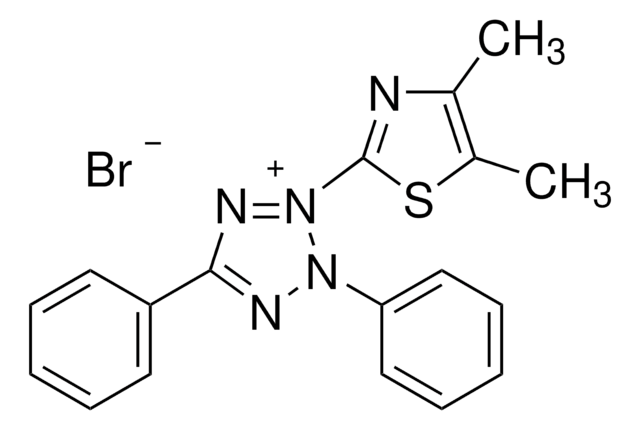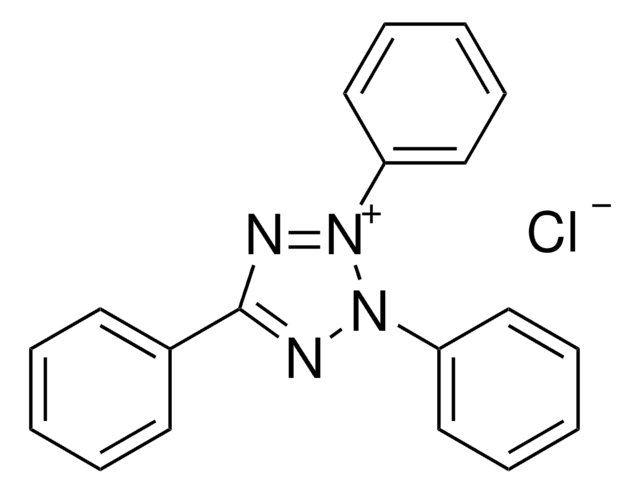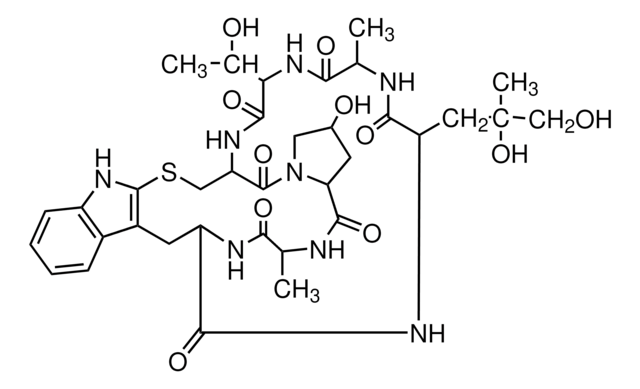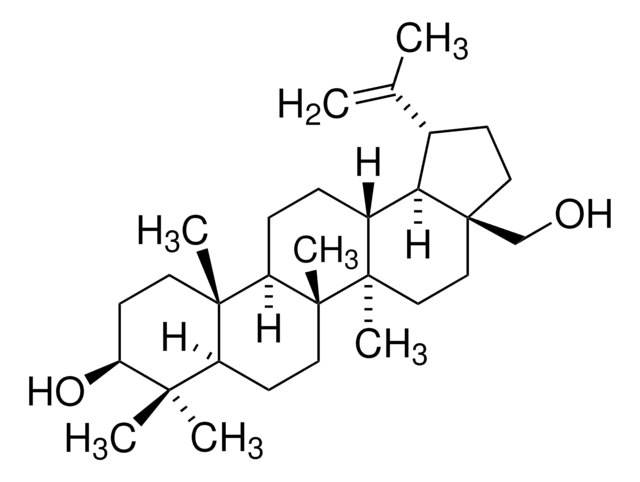50556
Phalloidin–Atto 390
BioReagent, suitable for fluorescence, ≥90% (HPLC)
Synonyme(s) :
Atto 390–Phalloidin
Se connecterpour consulter vos tarifs contractuels et ceux de votre entreprise/organisme
About This Item
Code UNSPSC :
12352116
Nomenclature NACRES :
NA.32
Produits recommandés
Gamme de produits
BioReagent
Niveau de qualité
Essai
≥90% (HPLC)
Fabricant/nom de marque
ATTO-TEC GmbH
λ
in methanol
Absorption UV
λ: 382-388 nm Amax
Adéquation
suitable for fluorescence
Température de stockage
−20°C
Description générale
Atto 390 Phalloidin is a novel fluorescent label with a coumarin structure. The dye is intended for application in the area of life science, e.g. labeling of DNA, RNA or proteins. Characteristic features of the label are high fluorescence quantum yield, large Stokes-shift, good photostability and low molecular weight.Phalloidin is a fungal toxin isolated from the poisonous mushroom Amanita phalloides. Its toxicity is attributed to the ability to bind F actin in liver and muscle cells. As a result of binding phalloidin, actin filaments become strongly stabilized. Phalloidin has been found to bind only to polymeric and oligomeric forms of actin, and not to monomeric actin. The dissociation constant of the actin-phalloidin complex has been determined to be on the order of 3 x 10–8. Phalloidin differs from amanitin in rapidity of action; at high dose levels, death of mice or rats occurs within 1 or 2 hours.
Application
Fluorescent conjugates of phalloidin, rhodamine-phalloidin staining reagents, such as Phalloidin–Atto 390 are used to label actin filaments for histological applications. Some structural features of phalloidin are required for the binding to actin. However, the side chain of amino acid 7 (g-dihydroxyleucine) is accessible for chemical modifications without appreciable loss of affinity for actin.
Informations légales
This product is for Research use only. In case of intended commercialization, please contact the IP-holder (ATTO-TEC GmbH, Germany) for licensing.
Code de la classe de stockage
11 - Combustible Solids
Classe de danger pour l'eau (WGK)
WGK 3
Point d'éclair (°F)
Not applicable
Point d'éclair (°C)
Not applicable
Équipement de protection individuelle
Eyeshields, Gloves, type N95 (US)
Faites votre choix parmi les versions les plus récentes :
Déjà en possession de ce produit ?
Retrouvez la documentation relative aux produits que vous avez récemment achetés dans la Bibliothèque de documents.
Chloé Clouzeau et al.
Molecular vision, 18, 851-863 (2012-04-25)
Benzalkonium chloride (BAK), the most commonly used preservative in eye drops, is known to induce ocular irritation symptoms and dry eye in long-term treated patients and animal models. As tear film hyperosmolarity is diagnostic of some types of dry eye
Y Ren et al.
Archives of biochemistry and biophysics, 323(1), 205-214 (1995-10-20)
Prostaglandin H synthase-1 is an integral endoplasmic reticulum membrane protein which catalyzes a key control step in prostaglandin biosynthesis. The overall arrangement of the prostaglandin H synthase-1 polypeptide with respect to the endoplasmic reticulum membrane was examined in transiently transfected
Małgorzata Maksymowicz et al.
Cell communication and signaling : CCS, 18(1), 176-176 (2020-11-06)
Lymphotoxin β receptor (LTβR) is a member of tumor necrosis factor receptor (TNFR) superfamily which regulates the immune response. At the cellular level, upon ligand binding, the receptor activates the pro-inflammatory NF-κB and AP-1 pathways. Yet, the intracellular distribution of
Stimulated emission depletion-based raster image correlation spectroscopy reveals biomolecular dynamics in live cells.
Hedde P.N.; et al.
Nature Communications, 4, 2093-2093 (2013)
SNARE Function Is Not Involved in Early Endosome Docking.
Geumann, U.; et al.
Molecular Biology of the Cell, 19(12), 5327-5337 (2008)
Notre équipe de scientifiques dispose d'une expérience dans tous les secteurs de la recherche, notamment en sciences de la vie, science des matériaux, synthèse chimique, chromatographie, analyse et dans de nombreux autres domaines..
Contacter notre Service technique






